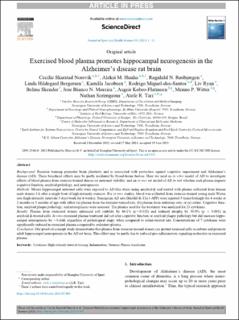| dc.contributor.author | Norevik, Cecilie Skarstad | |
| dc.contributor.author | Huuha, Aleksi Matias | |
| dc.contributor.author | Røsbjørgen, Ragnhild | |
| dc.contributor.author | Bergersen, Linda Hildegard | |
| dc.contributor.author | Jacobsen, Kamilla | |
| dc.contributor.author | Miguel dos Santos, Rodrigo | |
| dc.contributor.author | Ryan, Liv | |
| dc.contributor.author | Skender, Belma | |
| dc.contributor.author | Bianco Nascimento Moreira, Jose | |
| dc.contributor.author | Kobro-Flatmoen, Asgeir | |
| dc.contributor.author | Witter, Menno Peter | |
| dc.contributor.author | Scrimgeour, Nathan Robert | |
| dc.contributor.author | Rafiee Tari, Atefe | |
| dc.date.accessioned | 2024-02-21T14:11:10Z | |
| dc.date.available | 2024-02-21T14:11:10Z | |
| dc.date.created | 2023-10-03T08:40:19Z | |
| dc.date.issued | 2023 | |
| dc.identifier.citation | Journal of Sport and Health Science. 2023, . | en_US |
| dc.identifier.issn | 2095-2546 | |
| dc.identifier.uri | https://hdl.handle.net/11250/3119086 | |
| dc.description.abstract | Background
Exercise training promotes brain plasticity and is associated with protection against cognitive impairment and Alzheimer's disease (AD). These beneficial effects may be partly mediated by blood-borne factors. Here we used an in vitro model of AD to investigate effects of blood plasma from exercise-trained donors on neuronal viability, and an in vivo rat model of AD to test whether such plasma impacts cognitive function, amyloid pathology, and neurogenesis.
Methods
Mouse hippocampal neuronal cells were exposed to AD-like stress using amyloid-β and treated with plasma collected from human male donors 3 h after a single bout of high-intensity exercise. For in vivo studies, blood was collected from exercise-trained young male Wistar rats (high-intensity intervals 5 days/week for 6 weeks). Transgenic AD rats (McGill-R-Thy1-APP) were injected 5 times/fortnight for 6 weeks at 2 months or 5 months of age with either (a) plasma from the exercise-trained rats, (b) plasma from sedentary rats, or (c) saline. Cognitive function, amyloid plaque pathology, and neurogenesis were assessed. The plasma used for the treatment was analyzed for 23 cytokines.
Results
Plasma from exercised donors enhanced cell viability by 44.1% (p = 0.032) and reduced atrophy by 50.0% (p < 0.001) in amyloid-β-treated cells. In vivo exercised plasma treatment did not alter cognitive function or amyloid plaque pathology but did increase hippocampal neurogenesis by ∼3-fold, regardless of pathological stage, when compared to saline-treated rats. Concentrations of 7 cytokines were significantly reduced in exercised plasma compared to sedentary plasma.
Conclusion
Our proof-of-concept study demonstrates that plasma from exercise-trained donors can protect neuronal cells in culture and promote adult hippocampal neurogenesis in the AD rat brain. This effect may be partly due to reduced pro-inflammatory signaling molecules in exercised plasma. | en_US |
| dc.language.iso | eng | en_US |
| dc.publisher | Elsevier | en_US |
| dc.rights | Attribution-NonCommercial-NoDerivatives 4.0 Internasjonal | * |
| dc.rights.uri | http://creativecommons.org/licenses/by-nc-nd/4.0/deed.no | * |
| dc.title | Exercised blood plasma promotes hippocampal neurogenesis in the Alzheimer's disease rat brain | en_US |
| dc.title.alternative | Exercised blood plasma promotes hippocampal neurogenesis in the Alzheimer's disease rat brain | en_US |
| dc.type | Peer reviewed | en_US |
| dc.type | Journal article | en_US |
| dc.description.version | publishedVersion | en_US |
| dc.source.pagenumber | 0 | en_US |
| dc.source.journal | Journal of Sport and Health Science | en_US |
| dc.identifier.doi | 10.1016/j.jshs.2023.07.003 | |
| dc.identifier.cristin | 2181157 | |
| dc.relation.project | Norges forskningsråd: 223255 | en_US |
| cristin.ispublished | true | |
| cristin.fulltext | original | |
| cristin.qualitycode | 1 | |

